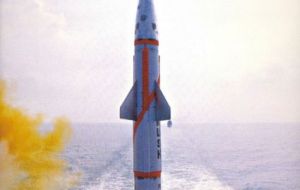MercoPress. South Atlantic News Agency
Global military spending increase 37% in 10 years
 Report: Risk of nuclear warfare rising
Report: Risk of nuclear warfare rising Global military spending rose 3.5% last year to $1.2 trillion (610 billion pounds) as U.S. costs for operations in Iraq and Afghanistan mounted, a European research body said on Monday in an annual study.
The United States spent $529 billion, slightly less than the entire GDP of the Netherlands, on military operations in 2006, up 5% over the previous year, the Stockholm International Peace Research Institute (SIPRI) said in its latest year book. "Taking both immediate and long-term factors into account, the overall past and future costs until year 2016 to the USA for the war in Iraq have been estimated at 2,267 billion," it said. Military spending in China, which is modernising its People's Liberation Army, climbed to an estimated 49.5 billion last year from 44.3 billion in 2005. "China's military expenditure continued to increase rapidly, for the first time surpassing that of Japan and hence making China the biggest military spender in Asia and the fourth biggest in the world," the institute said. The institute, which conducts independent research on international security, armaments and disarmament, said Japan cut military expenditure in 2006 for a fifth year running and was focusing its military budget primarily on missile defence. China and Japan, Britain and France accounted for about 4 to 5 percent each of global military expenditure last year, SIPRI said. The five biggest spenders' share of global military expenses was nearly two-thirds of the total. The United States and Russia were the largest arms suppliers in 2002 through 2006, each accounting for about 30 percent of global shipments, while deliveries from EU members made up another 20 percent, the institute said. "Almost 50 percent more conventional weapons, by volume, were transferred internationally in 2006 than in 2002, according to data gathered by SIPRI," it added. China and India remained the largest arms importers in the world, while five Middle Eastern countries figured among the top ten importers of arms globally. "While much media attention was given to arms deliveries to Iran, mainly from Russia, deliveries from the USA and European countries to Israel, Saudi Arabia and the United Arab Emirates were significantly larger," the institute said. Combined arms sales from the world's top 100 companies totaled 290 billion dollars for 2005. Some 40 of the largest exporters are based in the US, according to a Stockholm peace institute. In the report, SIPRI examined 100 top defense companies, 40 of which are based in the US and account for 63 percent of global arms sales. The 32 European companies included in the report had a 29-percent share while nine in Russia pulled in 2 percent of sales. Here is a list of the 10 largest arms exporting countries in terms of billions of dollars in sales. 1. USA : 7.9 2. Russia : 6.7 3. Germany : 3.9 4. France : 1.6 5. Britain : 1.1 6. Netherlands : 1.5 7. Italy : 0.9 8. China : 0.6 9. Sweden : 0.5 10. Israel : 0.2 In its report, SIPRI also included statistics on the number of armed conflicts, personnel deployed in peacekeeping operations (167,000 worldwide of which 19,000 were non-military), nuclear weapons, energy and security policy. SIPRI was created by the Swedish parliament as an independent foundation in 1966 and has been publishing its yearbooks ever since.




Top Comments
Disclaimer & comment rulesCommenting for this story is now closed.
If you have a Facebook account, become a fan and comment on our Facebook Page!